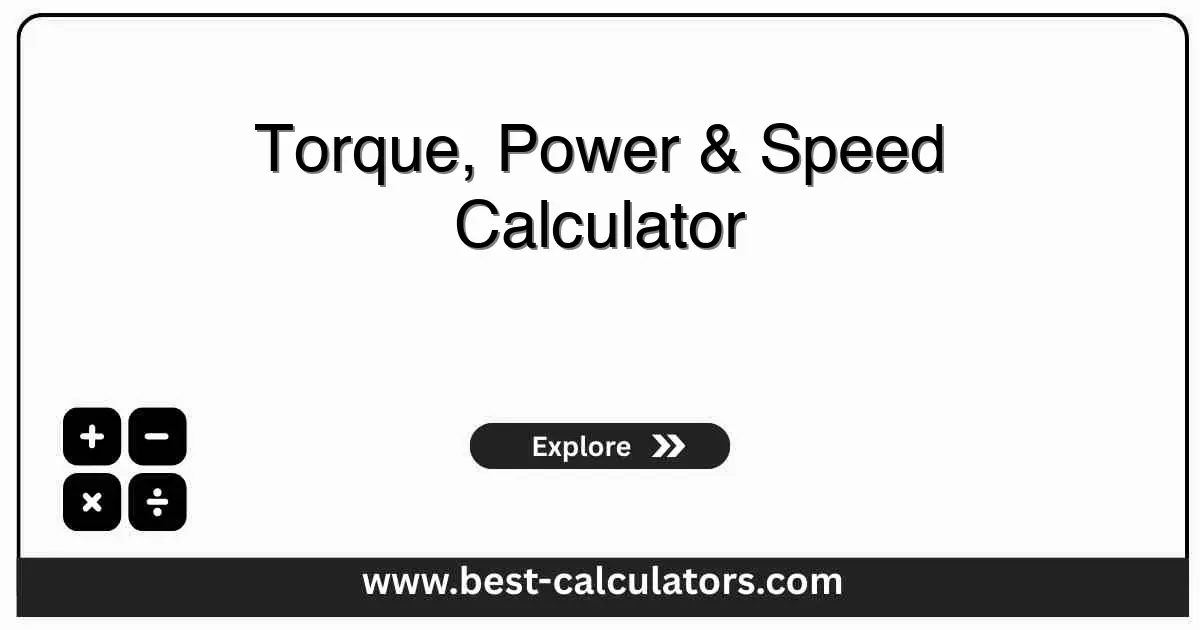Torque, Power & Speed Calculator - Rotational Mechanics
Calculate power, torque, and rotational speed relationships for motors, engines, and rotating machinery
Torque, Power & Speed Calculator
Results
Formula: P = τ × ω = τ × (2π × N / 60)
What is Torque, Power & Speed Calculator?
A Torque, Power & Speed Calculator is a free engineering tool that calculates the relationship between rotational power, torque, and speed in rotating machinery. This fundamental relationship P = τ × ω governs all rotating systems from electric motors to car engines.
This calculator is essential for:
- Motor Selection - Choosing appropriate motors based on power and torque requirements
- Mechanical Design - Sizing shafts, gears, and couplings for rotating machinery
- Engineering Education - Learning rotational dynamics and power transmission
- Performance Analysis - Evaluating engine and motor performance characteristics
For spring mechanics, try our Spring Constant & Deflection Calculator.
For beam analysis, use our Beam Bending Stress Calculator.
How Torque, Power & Speed are Related
The calculation uses the fundamental rotational power equation:
Where angular velocity ω relates to RPM:
Combined formula:
Where:
- P = Power (W, kW, or HP)
- τ = Torque (N·m or lb-ft)
- ω = Angular velocity (rad/s)
- N = Rotational speed (RPM)
Unit conversions:
- 1 HP = 745.7 W
- 1 lb-ft = 1.356 N·m
- 1 RPM = π/30 rad/s ≈ 0.1047 rad/s
Key Rotational Mechanics Concepts
Torque (τ)
Rotational force causing rotation. The rotational equivalent of linear force. Measured in N·m or lb-ft.
Power (P)
Rate of doing work or energy transfer. In rotation: product of torque and angular velocity. Measured in watts or HP.
RPM (N)
Revolutions per minute. Common speed unit for motors and engines. One revolution = 360° = 2π radians.
Angular Velocity (ω)
Rate of rotation in rad/s. SI unit for rotational speed. Related to RPM: ω = 2πN/60.
How to Use This Calculator
- Choose Calculation Type: Decide which parameter to calculate (power, torque, or speed)
- Enter Known Values: Input ANY TWO of the three parameters (power, torque, or speed)
- Select Units: Choose appropriate units for each parameter from dropdown menus
- Calculate: Click "Calculate" to compute the unknown parameter
- Review Results: All values displayed in selected units plus angular velocity
- Reset: Click "Reset" to clear all values and start a new calculation
Example 1: Find Power
Torque = 100 N·m, Speed = 3000 RPM
P = 100 × (2π × 3000 / 60) = 31,416 W ≈ 31.4 kW
Example 2: Find Torque
Power = 10 HP (7457 W), Speed = 1800 RPM
τ = 7457 / (2π × 1800 / 60) = 39.6 N·m
Benefits of Using This Calculator
- Instant Calculations: Solve for any parameter in seconds with accurate 2025 formulas
- Multiple Units: Support for W, kW, HP, N·m, lb-ft, RPM, and rad/s
- Flexible Input: Enter any two parameters to calculate the third automatically
- Engineering Accuracy: Uses standard mechanical engineering formulas
- Educational Tool: Perfect for learning rotational dynamics and power transmission
- Professional Use: Suitable for motor selection, drivetrain design, and performance analysis
- Angular Velocity: Automatically calculates and displays ω in rad/s
Common Applications & Use Cases
- Electric Motors: Selecting motors based on required torque and speed for applications
- Automotive Engines: Calculating engine power from torque curves and RPM data
- Gearbox Design: Determining output torque and speed after gear reduction
- Pump & Fan Selection: Matching motor power to pump/fan load requirements
- Machine Tools: Calculating spindle power from cutting torque and speed
- Wind Turbines: Determining generator power from blade torque and rotational speed
- Conveyor Systems: Sizing drive motors for material handling applications
- Performance Testing: Analyzing dynamometer test results for engines and motors

Frequently Asked Questions (FAQ)
What is the relationship between torque, power, and speed?
Power is the product of torque and angular velocity: P = τ × ω. In practical units, P (watts) = τ (N·m) × 2π × N (RPM) / 60. This means power increases linearly with both torque and rotational speed.
How do I convert between RPM and rad/s?
To convert RPM to rad/s: ω (rad/s) = N (RPM) × 2π / 60. To convert rad/s to RPM: N (RPM) = ω (rad/s) × 60 / 2π. One revolution equals 2π radians.
What is torque in rotational mechanics?
Torque (τ) is the rotational equivalent of force. It represents the tendency of a force to rotate an object about an axis. Measured in N·m (Newton-meters) or lb-ft (pound-feet), it's the product of force and perpendicular distance from the axis.
How do you calculate power from torque and RPM?
Power (watts) = Torque (N·m) × 2π × RPM / 60, or simplified: P = τ × ω where ω is angular velocity in rad/s. For horsepower: HP = (Torque in lb-ft × RPM) / 5252.